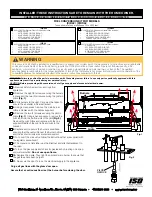
Page 4 of 12
INSTALLATION & SERVICING INSTRUCTIONS
(
continued)
APPLIANCE LOCATION
a.
This appliance must be hearth mounted in a builders opening or under an associated independent canopy or a fireplace
recess.
b.
On
NO ACCOUNT
must this appliance be sited on combustible materials or carpets. It is not suitable for combustible walls.
c.
When the appliance model has been supplied or specified with support legs, the appliance must be screwed firmly to the
hearth. In the case of freestanding basket models care should be taken to secure the burner to the given basket. In most
cases the burners for free standing models would have been made to ensure a correct and tight fit. Movement due to the
operation of the gas burner can cause leaks. If in doubt seek expert advice.
d.
Ensure that the burner tray fits neatly into the intended location, and that you have easy access to the controls.
e. Ensure that there is adequate airflow to the underside of the fire (through the fire front or fret etc.
This air is required
for cooling the underside of the fire & controls, as well as to provide the primary combustion air.
Do not use any front that
has
no slot or slots, you cannot rely on, or expect the user to space a solid front away from the fire to allow for the air supply.
For Fires with a manual control valve
a minimum primary air inlet of 50 sq. cm is usually enough.
Fires with the Thermatronic electronic control system
require more ventilation than specified above as the electronic
components need to be kept at a lower temperature to operate
– refer to the section headed Temperature Limits Of The
Electronic Components in the Thermatronic instructions.
Failure to observe this instruction is dangerous and breakdowns due to overheated controls are not covered by the
guarantee. If a fireplace is properly designed and installed the controls will not overheat
– it is the installer’s
responsibility to ensure that the installation does not allow the controls to overheat.
f.
Ensure that no naked flame or incandescent part of the fire bed projects beyond the vertical plane of the fireplace opening.
INSTALLATION OF THE APPLIANCE
Having ensured that the appliance application is correct and the requirements of the flue specification, ventilation demands and
the gas supply are correct, proceed with the installation and assembly as follows:
a. In common with all other gas appliances, dirt and debris in the gas system can block the valve and gas injectors on
this appliance, and faults caused by this are not covered by the guarantee. If you suspect that there is dirt and/or
debris in the gas distribution system, fit a filter in the pipeline, before the gas valve.
b.
Do not use jointing compound on any compression fittings on the burner or the control valve. The use of jointing compound on
the compression fittings on this appliance will possibly invalidate the guarantee, as it can get into the control valve mechanism
and cause it to malfunction.
c.
Ensure that there is an isolating valve in the gas supply line near the appliance.
d.
Connect the gas supply pipe from the isolating valve to the gas inlet coupling fixed to the gas burner. Make sure the supply
pipe does not obstruct access to the controls.
e.
Where there are fixing holes for the burner we recommend a secure fixing be made to the hearth or fire basket.
f.
Check that all gas connections are sound. The appliance has been factory tested; however the connections may have been
disturbed in transit or installation.
g.
With cast iron inset fires and sunken burners it is most important that they are properly back filled, to avoid the
possibility of a negative pressure being obtained underneath the fire resulting in flames being drawn down the sides
of the burner. This is dangerous and can cause problems, which include overheating the controls (electronic
systems are particularly sensitive to this) and spoiling the flame pattern.
h.
Open fires are a hazard; it is recommended that a guard be fitted to provide protection for children, the elderly, or infirm (see
National Regulations, if any).
i.
Do not adjust or put out of action the spillage monitoring system (oxypilot), or change any of its parts. Always comply with
ceramic layout in the pilot area.
j.
Use only original manufacturer's parts if any replacements are needed.
k.
If there is any concern about a pressure zone causing downdraught in certain wind conditions a suitable chimney cowl should
be fitted.






























